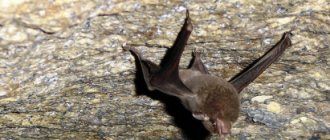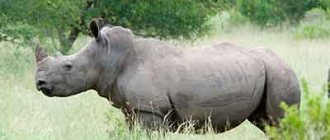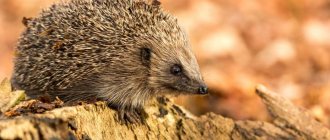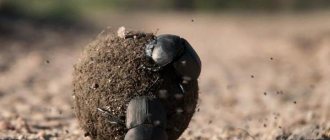The Latin species name of the Indian rhinoceros translates as “one-horned rhinoceros.” This species is also known as the armored rhinoceros. In Asia, the Indian rhinoceros is the second largest animal after the elephant, and among other species of Asian rhinoceros it is the largest.
Description of the Indian rhinoceros
— Advertising —
The Indian rhinoceros is a huge animal, whose weight sometimes reaches 2.5 tons or more. The height of males is about 2 m. Females are slightly smaller in size. The length of the horn is on average about 25 cm, sometimes reaching 60 cm. In females it is barely noticeable and resembles a bump on the nose. The skin of the Indian rhinoceros is naked, gray with a pinkish tint, and is divided into large sections by folds that hang down like a shell. For this reason, the name “armored” was given to the species. The color of the skin of a rhinoceros is usually difficult to distinguish, since the animal is almost always covered with a layer of mud in which it rolls. There are small tassels on the tail and ears. The paws are three-toed. There is a deep fold on the shoulders that is curved back. The eyes are small. The upper lip is slightly curved downwards. On the lower jaw there are strong incisors, with which the rhinoceros is capable of inflicting deep wounds.
The Indian rhinoceros, a powerful and majestic animal, gives the impression of a clumsy heavyweight, but this is deceptive. This animal is endowed with excellent reaction and mobility. In case of danger or for self-defense, the Indian rhinoceros can reach speeds of up to 40 km/h. He also has a well-developed sense of smell and hearing. The Indian rhinoceros can smell predators or people hundreds of meters away. Only his vision, like other species of rhinoceroses, is poorly developed.
Feeding characteristics of the Indian rhinoceros
The Indian rhinoceros is a herbivore whose diet includes aquatic plants, young shoots of reeds and elephant grass. He snatches food with his keratinized upper lip. Grazing occurs in the morning or evening, when it becomes cool; rhinoceroses wait out the heat in small lakes and puddles that are filled with liquid mud. Rhinoceroses also look for their food in bodies of water, which is why they are common only in wet, swampy areas.
Distribution of the Indian rhinoceros
— Advertising —
A couple of centuries ago, the Indian rhinoceros was distributed throughout the south and southeast of Asia, southern China, and eastern Iran. But human hunting, habitat destruction and competition for food with livestock have led to sharp declines in Indian rhino populations in most of these regions. The species practically ceased to be found outside nature reserves after the European colonization of Asia and the appearance of hunters armed with firearms. In addition, the population of Asian countries continued to grow during this period, and the area of the jungle decreased.
Currently, the Indian rhinoceros's habitat includes southern Pakistan (Sindh province), eastern India and Nepal, with a small population living in northern Bangladesh. At the same time, rhinoceroses live in strictly protected areas. The largest population is in the Kaziranga National Park in the Indian state of Assam, which contains about 1,600 individuals, that is, 2/3 of the total number of animals in the world. Another famous reserve is Chitwan Park (Nepal), where up to 600 individuals live. The Lal Suhantra Wildlife Sanctuary (Pakistan) is home to the third largest population of rhinoceroses, with 300 rhinoceroses. There are about 2,500 Indian rhinos in total, and the population is gradually increasing in size.
The Indian rhinoceros has been assigned the status of a vulnerable species in the International Red Book. But compared to the Sumatran and Javan rhinos, it is recognized as a prosperous species.
Where do they live?
Once upon a time, the family included a huge number of species, but climate change, as well as human activity, destroyed almost all of them, leaving only five main species. They all prefer to live in warm or even hot conditions, so they simply cannot be found on cold continents. The main habitat is considered to be Southeast Asia and South Africa. Some parts of the population of any of the species can be found in the steppe zones and savannas of the Congo, Mozambique or several other arid countries. In extreme cases, rhinoceroses begin to live in the tropics, even despite the presence of rain and a humid climate there.
Common species of Indian rhinoceros
The closest related species to the Indian rhinoceros is the Javan rhinoceros, which also belongs to the genus Indian rhinoceros (Rhinoceros).
Javan rhinoceros (Rhinoceros sondaicus)
The body length reaches 3 m, the height is about 1.7 m. There is one horn, up to 20 cm long.
A rare species, the population size does not exceed 60 individuals. Attempts to keep the Javan rhinoceros in captivity have been unsuccessful.
Indian rhinoceros behavior
Rhinoceroses prefer to lead a solitary lifestyle. Each animal occupies an individual plot of up to 4000 m2. On its territory there are dense thickets of elephant grass, a puddle, a small lake or the shore of a large reservoir. Males mark the area with piles of dung.
In the habitats of the species, thickets of elephant grass are crossed by numerous rhino trails, both public, which lead to mud baths, and “private”, which are guarded by the owner.
Indian rhinoceroses are excellent swimmers and are able to swim across even wide rivers.
The Indian rhinoceros has an inexpressive voice. If the animal is disturbed, it emits a kind of snoring. The female grunts to call her cubs, and during the mating season she makes a special whistle. Grunting is also produced by grazing rhinoceroses. When injured or in danger, Indian rhinoceroses begin to roar loudly.
Rhinoceroses have a very aggressive character. An irritated rhinoceros can even attack an elephant, and it is practically impossible to escape from it. Such attacks may be unprovoked, and therefore it is not recommended to approach Indian rhinoceroses. During an attack, the rhinoceros does not use its horn, but fights with the incisors of the lower jaw and delivers deep cutting blows with them.
Structure
As the name suggests, the key feature of the rhinoceros's body structure is the horn located on the frontal or nasal bone. Usually this is a single growth, but it can also be a pair of growths. Unlike other animals that also have horns or other outgrowths, such as antelopes or bulls, the horn of a giant mammal is not made of bone tissue, but of the protein keratin. It also makes up the quills of hedgehogs, porcupines, human nails and hair, and even the shells of turtles and armadillos. The composition of these horns is very similar to their hooves. Development occurs from the epidermis, so the outgrowth is not a separate part of the skeleton. If wounded or completely destroyed, the horn is restored, but if it is beaten off along with the root, the adult will forever lose its main weapon. No matter how much time a person spent studying the role of horns in the life of an animal, their main function could not be learned. But you can notice that females, after removing their horns, do not want to enter into relationships with the opposite sex and completely forget about their offspring. At the moment, the most likely theory is the convenience of the rhinoceros, which, with the help of its outgrowth, moves apart trees and grass to find better and more nutritious food. This version is also confirmed by age-related changes in the structure of the horns themselves, which become denser over time, but become smoother.
Indian rhinoceros breeding
Female Indian rhinoceros reach sexual maturity at the age of 3-4 years, males at 7-9 years.
The Indian rhinoceros's rut occurs every 1.5 months. During this period, the female pursues the male. Pregnancy lasts 16-17 months, after which one baby is born weighing up to 65 kg, with pink skin with folds and outgrowths, but without a horn.
The life expectancy of the Indian rhinoceros in captivity reaches 70 years, in natural conditions it is much less.
Natural enemies of the Indian rhinoceros
Predators do not hunt Indian rhinoceroses. Only tigers can attack rhino cubs. And in a fight with an adult rhinoceros, they have no chance of winning. This species is not even afraid of the Indian elephant, but boldly rushes at it and forces it to leave.
The Indian rhinoceros suffers mainly from skin parasites, ticks and lice, from which birds save it. The young are harmed by helminthic infestations.
Habitat
While the first African rhinos inhabited almost the entire black continent, and the Asian subspecies lived throughout Asia due to poachers and agricultural expansion, their natural environment deteriorated significantly.
At one time, rhinoceroses inhabited the entire territory of two continents
Asian rhinoceroses are found only in India, Pakistan, Nepal, Java and Sumatra and may have survived in Bangladesh. The animals prefer to live in swampy areas and tropical forests, but they can also live in lush plains covered with vegetation.
The pachyderm giants of Africa live in arid savannas and forests, and their natural range is widespread in the following countries:
- SOUTH AFRICA;
- Mozambique;
- South Sudan;
- Congo;
- Namibia;
- Zimbabwe;
- Tanzania;
- Kenya;
- Angola;
- Zambia.
Although rhinoceroses lead a free lifestyle, most of them are confined to nature reserves and national parks, where it is easier for police patrols and special forces to ensure that these animals do not become victims of poachers.
Interesting facts about the Indian rhinoceros:
- The permanent neighbors of the Indian rhinoceros are birds, for example, herons, mynah starlings, and bee-eaters. They catch insects that the rhinoceros scares away, or peck ticks on its skin.
- The Indian rhinoceros was the first rhinoceros to be seen by Europeans. The first known image of this animal was created by Dürer. The artist created his engraving “Rhinoceros” without seeing the animal, so it looks a little strange, as if “chained” in iron armor. This Indian rhinoceros was brought to Lisbon in 1513 from India from the Rajah of Cambay as a gift to the Portuguese King Manuel I. It was later put on public display and sent as a gift to the Pope. But during transportation, the ship and the rhinoceros sank during a storm.
- Rhino hunting was a popular pastime among Indian feudal lords. Miniatures of the 16th-17th centuries. depict the padishahs of the Mughal dynasty hunting rhinoceroses on elephants.
- The main threat to the Indian rhinoceros population has become poaching, which is associated with legends about the miraculous power of its horn. Residents of Asia endowed it with aphrodisiac and anti-poison properties. Therefore, the price of horns on the black market is very high, and poor Asians are trying to get rich through illegal hunting. In this regard, in India in the 70-80s of the last century, strict laws were passed to protect Indian rhinoceroses.
Rhinoceroses are large herbivorous mammals that are easily recognized by their characteristic horn. The word "rhinoceros" comes from the Greek "rhino" (nose) and "ceros" (horn). There are 5 species and 11 subspecies of rhinoceros. Some have two horns, while others have one.
Since the animal's horns are used in folk medicine for their supposed healing properties, rhino hunting has led to the near extinction of these animals. Their horns are sometimes sold as trophies or decorations, but more often they are ground up and used in traditional Chinese medicine. The powder is often added to food or brewed into tea, and the horn is believed to be a powerful aphrodisiac, a cure for hangovers, fever, rheumatism, gout and other disorders, says the International Rhino Foundation.
It is estimated that there were 500,000 rhinoceroses in Asia and Africa at the beginning of the 20th century. Today they are reported to number around 29,000 in the wild. Poaching and habitat loss have put all rhino species at risk of extinction. (2013 was a record year for rhino poaching in South Africa).
According to the International Union for Conservation of Nature Red List of Threatened Species:
Sumatran rhinos, black rhinos and Javan rhinos are “endangered” and have the highest risk of extinction. There are 5,055 black rhinos, less than 100 Sumatran rhinos and only 35-44 Javan rhinos.
Video. Rhino attacks on people
Greater one-horned rhinoceroses are "vulnerable," meaning they could be at risk of extinction if circumstances do not improve. Fortunately, their population is growing. There are 3,333 great horned rhinoceroses in the world. According to the IUCN, the total population in 2007 was 2,575 individuals.
White rhinos are “endangered,” which means they could become extinct in the near future. The southern white rhinoceros has a growing population, with an estimated 20,405 southern white rhinoceros. However, the northern white rhinoceros is considered "extinct" in the wild.
Interesting facts about rhinoceroses 1. There are five different types of rhinoceroses. Three in South Asia and two in Africa. These are the white rhinoceros, black rhinoceros, Indian rhinoceros, Sumatran rhinoceros and Javan rhinoceros.
2. The white rhinoceros is the second largest land mammal. The white rhinoceros is the largest rhinoceros and can weigh over 3,500 kg (7,700 lb) and is the largest land mammal after the elephant. Elephants can weigh up to 7,000 kg (15,000 lb)
3. Rhinos can grow over 6 feet tall and over 11 feet long.
4. Three of the five species of rhinoceroses are classified as endangered species. Javanese, black and Sumatran are all critically endangered, meaning they have a 50% chance of becoming extinct within three generations.
5. Rhinos have thick, sensitive skin. Rhino skin may be thick, but it can be very sensitive to sunburn and insect bites, which is why they love to roll around to let the dirt dry on their skin, which acts as protection against sunburn and insects.
6. Relative to their large size, rhinoceroses have small brains. But that doesn't mean they are stupid.
Photo. Rhino hunting
7. Rhino horn is made of a protein called keratin, the same substance that makes up nails and hair. A rhinoceros's horn is not a bone and is not attached to its skull. They are also not empty, like the tusks of an elephant. It is actually a compacted mass of hair that grows throughout the animal's life cycle, just like human hair and nails. The longest known black rhinoceros horn measured 4 feet 9 inches.
8. Some rhinoceroses use their teeth rather than their horn as protection. When a rhinoceros is threatened by a more horned rhinoceros, it cuts and gouges its opponent with long, sharp fangs and incisors located on the lower jaw.
9. Rhinoceroses are herbivores. They must eat a lot to satiate their large bodies.
10. A group of rhinoceroses is called a “herd”.
11. Despite their name, black and white rhinoceroses are actually gray. The name of the white rhinoceros is taken from the African word "weit", which means "wide" and describes its mouth. Early English settlers in South Africa misinterpreted the word "weit" to mean "white". Black rhinoceroses probably got their name from the dark, wet mud on their skin that made them appear black. Both species are essentially gray in color.
12. The closest living “relatives” of rhinoceroses are horses, tapirs and zebras. They are part of a group of mammals called equids.
13. Rhinos are fast cars. They can run at speeds of up to 30-40 mph, while the fastest running human can reach speeds of 15 mph, so finding a tree and climbing it is a better strategy than trying to outrun a rhino!
14. Rhino pregnancy lasts a very long time. At least they are pregnant for 15-16 months! Female rhinos are very attached to their babies. The young stay with their mothers until they are 3 years old.
15. Rhinoceroses have poor eyesight, but their senses of smell (smell) and hearing are very well developed. A rhinoceros has difficulty detecting someone who is standing a hundred meters away from them if the object does not move. However, if a person makes a faint sound or a rhinoceros can smell a person, it will easily detect it even at a much greater distance. The olfactory region is the largest region of the rhinoceros brain.
16. African rhinoceroses are a good “home” for buffalo starlings. Buffalo Starlings (Wolf Starlings) feed on ticks and other insects they find on the rhinoceros and make noise when they sense danger. This also helps alert the rhino.
17. Rhinoceros communicates using dung! Rhinos use piles of dung to leave "messages" for other rhinos. Each rhino's scent is unique and identifies its owner. It can also tell a rhinoceros about another rhinoceros, how young or old it is, male or female. They also communicate to other rhinos that this is their territory.
Photo. Rhinoceros near the water
18. Rhinoceroses have been around for over 50 million years. They haven't changed much since prehistoric times (though of course they were covered in fur back then). Some of the first rhinoceroses did not have horns and once roamed throughout North America and Europe. No species of rhinoceros has ever lived on the South American or Australian continents.
19. The Sumatran rhinoceros is the closest living relative of the ancient, extinct woolly rhinoceros. These rhinoceroses were large with long hair and were hunted by ancient people, as depicted in cave paintings that are over 30,000 years old.
20. How They Eat Matters The black rhinoceros has a hooked lip that allows it to feed on bushes and trees. The white rhinoceros has a long, flat upper lip, ideal for plucking grass. The upper lips of three Asian rhinoceros species allow these animals to comb vegetation in tropical forests.
When do rhinoceroses attack people? Rhino attacks on people are very rare. In fact, there are fewer than two attacks each year, and most of them are non-fatal. Although the black rhinoceros is known for its aggression, it is not often that it shows its aggression to humans as rhinoceroses are solitary creatures by nature.
They prefer to wander unhindered and serene across the plains of their territory. While white and black rhinos are more likely to attack, Sumatran, Indian and Javan rhinos are more likely to flee from danger. This does not mean that the last three species are completely safe for humans.
The most common situation in which a rhinoceros will attack is when a female rhinoceros is protecting her calf. Any precondition for a threat to her calf will cause her aggression and provoke a defense mechanism in her. People approaching the animals must immediately leave the area if there is a female rhinoceros with her calf among the animals.
Most of the attacks on cars and other vehicles were caused by onlookers wanting to get to know the mother and her child better. The mother instinctively wants to get rid of the intruders in order to ensure the safety of her calf. These females are known to take out their venom on vehicles and cause great damage to them.
Photo. Rhinoceros with baby
Most of the damage done during a rhino attack is due to its brute strength. An adult rhinoceros can weigh up to three tons. In addition, its horn used in attacks can cause extreme harm to an animal, person or vehicle.
The rhino's goal is not to hurt or kill the people inside the vehicle, but to get them out of sight as quickly as possible. The ramming of the car occurs due to the very poor vision of the rhinoceros. Therefore, the best defense is to leave the area immediately. People traveling through rhino territory should ensure that there is always a safe escape route or tree they can safely climb until the rhino leaves the area. Once the threat is out of sight, the rhino will not pursue it.
However, before attacking a person, the rhinoceros will snort loudly, thereby giving a warning. This should be taken seriously. As soon as the animal starts to get angry, it can accelerate to 56 kilometers per hour. The rhinoceros can also quickly and deftly change direction if necessary.
It is important for those who come into contact with a rhinoceros not to cause it stress or fear, which could lead to an attack. Stay away from the calf and respond to warnings by leaving the area immediately.
Rhino attacks on people Attacks in Nepal Rhino attacks are relatively rare in Asia, partly because rhinos are very rare there and many live in remote forests and jungles where there are few people. Most attacks in Asia involve Indian rhinoceroses. In February 2010, the Kathmandu Post reported: “An elderly man was killed in a rhino attack in Nawalparashi district in southern Nepal. According to local residents, the wild animal attacked Asamdhar Sigdel of Kumarbati when he was going to fetch water at 6 am.”
In January 2011, a rhinoceros in Nepal was sent to "jail" for killing a human. The Hindustan Times reported: “A rhinoceros in Nepal faces one-year 'jail' for killing a human. Authorities in Bardiya National Park in western Nepal kept this blind rhinoceros, called Vikram, in a small enclosure measuring 1 katha (720 square feet) for killing a 60-year-old priest. The orphan rhinoceros was brought to Bardia from Chitwan National Park in 2002 after the blind animal was severely injured by nearby villagers.”
Due to his blindness, Vikram was popular among park visitors. Many are accustomed to approaching him and taking photographs. Nepalese Army personnel were stationed in the park for security purposes, and Bardiya National Park personnel also took a liking to Vikram. But that was before the attack on the man Bahadur Rana, a priest at a local Hindu temple. Vikram's prison term began after the "victim" succumbed to his injuries. “Even we feel bad keeping such a docile animal in captivity. But we have no choice because he could attack people again if he were free,” said Rasish Thapa, a park official. Another official website said that Vikram moved freely 15 kilometers a day in the park. But for now, he continues to move indoors and Vikram will remain in the 'jail' for another five months before being moved to another part of the park.
The last case of a rhino attack in Nepal occurred in March 2015, when a rhino escaped from a sanctuary wandered into a city and killed one woman and injured 6 people. With the help of trained elephants, they managed to return the rhinoceros to its environment.
Rhino Attacks in India In October 2011, The Indian Express reported: “A male rhino that strayed from the Gorumara Wildlife Sanctuary attacked a photographer and threw him into the air several times. According to officials, the incident occurred when photographer Dipankar Ghatak tried to take photographs of the animals by approaching them. Prior to this incident, the rhinoceros scared the living daylights out of the residents of Fatakpara by attacking them threateningly. A large number of spectators and foresters had difficulty driving the animal back into the forest.”
A rhinoceros came out of the forest of the Gorumara Nature Reserve in the morning. The photographer, along with other people, went on a boat and crossed two rapids to find the animal. While he was taking photographs, the animal rushed towards him and threw him high. Rajda Mahtolia, chief conservator of forest (wildlife) of North Bengal, told The Indian Express that the photographer was lucky to escape with his life. He suffered hip and back injuries and was admitted to a nursing home. No internal injuries were reported. The next day, the one-horned rhino was led deep into the Gorumara Wildlife Sanctuary by four trained elephants. “Our patrol team and the animals followed the tracks and the animal was left deep in the forest,” Rajda Mahtolia said.
In October 2007, a rhinoceros killed a man at the Lucknow Zoo. The media reported: “32-year-old Vinod, who entered the rhino enclosure behind a kite, was killed by the animal. This is the second such case in the last ten years. Lucknow Zoo authorities were informed last night that a man from a nearby area entered the zoo to retrieve a kite that had landed inside. When Vinod did not return, the zoo and local residents began a search. The next morning, zoo staff discovered Vinod's injured body in the rhino's pen. A zoo spokesman said the animal killed him. By the way, the same rhinoceros killed a veterinarian in 1996.
Rhino Attacks in Africa Rhino attacks are more common in Africa, especially involving black rhinos, which have a more vicious reputation. In June 2012, The Herald reported: “A ranger at Mount Zebra National Park near Cradock, South Africa, was rammed by a rhinoceros during a routine evening patrol of the park. Donovan Anthony, 28, is in a stable condition at St George's Hospital in Port Elizabeth. Three other rangers on patrol with Anthony escaped injury."
“Anthony was taken to Cradock Hospital in Nelson Mandela Bay with chest and stomach injuries. His mother Rayna Allens said: “Details of the attack are still sketchy. I was told that he was attacked by a rhinoceros that had just given birth to a baby. He has bruises on his chest and doctors say the blow could cause serious internal injuries, so he was transferred to St George's Hospital for more x-rays and tests. I still don't know what led to the attack." She said Anthony, her eldest son, always loved working with animals. "I don't know if this attack will diminish his love for animals."
Park spokeswoman Megan Taplin said such an attack was rare because rhinos have poor eyesight and usually only get angry when they feel threatened. "He came out of the bush and he was surprised, as were the rangers who were doing regular patrols," Taplin said. “Apparently the rhino was aggressive because it was surprised by the rangers... We are just grateful that there were no further injuries as the other rangers managed to get out of the way in time. Rhinos don't usually attack." Taplin said the rhino that attacked rangers would not be euthanized because there was nothing wrong with it, it was just a surprise to the four men.
In September and October 2004, two people were gored by rhinoceroses in South Africa. A second person was gored by a black rhinoceros in the Hluhluwe-Umfolozi Game Reserve, KwaZulu-Natal conservation authorities say. In the latest incident, one of a group of workers was clearing excess vegetation in the reserve when he came across a black rhinoceros, which attacked him. The workers had seen the rhinoceros before, but waited for it to leave before continuing their work. Empangeni Clinic spokeswoman Venesca Fourie said Magubane was in a stable condition in the intensive care unit after undergoing emergency surgery. She said the rhino punctured Magubane's back and broke several ribs.
Two weeks earlier, Kirsten Bond, a zoology research fellow at the University of Port Elizabeth, was gored by a black rhinoceros at the sanctuary while collecting dung samples as part of a black rhino population expansion project. Her family said she suffered multiple injuries to her legs and lower torso. She has undergone two operations and is in intensive care at Richards Bay Hospital. The two incidents were "completely unrelated" and happened 30 kilometers apart.
In November 2011, a report appeared: “A man was attacked by a black rhinoceros near the southern part of the Kruger National Park in Limpopo, doctors say.” The man was rammed by a rhino while walking, ER24 spokesman Derrick Banks said. The rhinoceros horn pierced his left arm, and he suffered blows to the head and bruised ribs on his left side, Banks said. "He's very lucky he didn't suffer any more serious injuries," Banks said. The 44-year-old man was hospitalized in stable condition.
In August 2012, a woman was attacked by a rhinoceros on a farm outside Bela-Bela, South Africa. Message: “Purette van Heerden, 42, an animal conservation enthusiast, volunteered to help move a rhino to a sanctuary in Limpopo. She was standing holding her 21-year-old daughter's hand as she watched farm workers load a female rhino and her calf when another rhino pounced on her and "flipped her over" repeatedly. When her daughter screamed, the rhino stopped. She suffered multiple fractures to her pelvis and then received emergency treatment at Pretoria Hospital. “Animals are my passion and when I am healthy again I will continue to help them... The incident was completely my fault, I was on their territory,” she said.
This entry was posted on Saturday, April 15, 2022 - 11:04 am. You can leave a comment.











